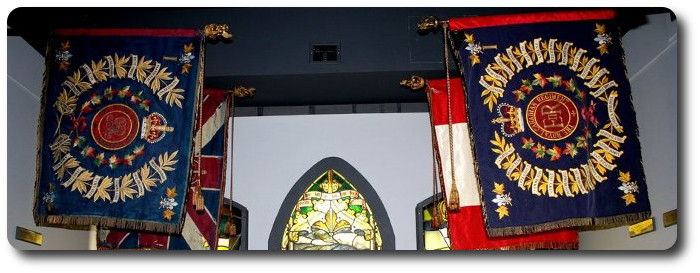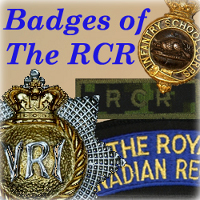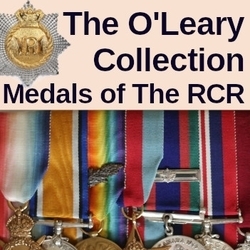
Researching The Royal Canadian Regiment
Narrative of 1 Bn RCR's Tour in the Line
Aug/Nov on HILL 355
The Connecting File; Winter-Spring 1953
At 2340 hrs 8 Aug 52 1 Bn The Royal Canadian Regiment relieved 1 Bn Welch Regiment in the line. The relief was uneventful and as the Royals settled into strange hunkers and groped their way along unfamiliar trenches there was no inkling of the hard fighting that was to come. Even so no man was unaware of the honour accorded to his Regiment in its being made responsible for the defence of Hill 355 for that feature, nicknamed by the Americans, "Little Gibraltar" is the key to the highways leading to Seoul.
On 28 Aug the RCR set out to gain control of the valley separating Hill 355 and the enemy positions. This was quickly done so that by 8 Sep an officer and 3 ORs were able to lie-up in "no-man's land" for 48 hours, direct artillery fire on observed groups of enemy, sketch enemy positions and return with information of such value that artillery and air strikes were later accurately directed against known enemy locations.
Two weeks later this same daring officer, Lt Russ Gardner, and five ORs went out once more and in broad daylight snatched an enemy signaller from under the noses of the enemy. A party of Chinamen who endeavoured to cut off the escape of Lt Gardner and his group were shot down. For this exploit Lt Gardner won the immediate award of the Military Cross and his second-in-command, then Cpl, now Sgt Fowler, was awarded the Military Medal.
But life was not all glory. Enemy shell and mortar fire caused casualties almost daily. Old-hands saw their buddies carried off the hill dead or wounded. Reinforcements going forward passed ambulances on their way to the rear areas. The arrival of helicopters to evacuate seriously wounded men became a fairly common occurrence. When enemy shell fire stopped, it seemed that rain started, bunkers leaked and trenches and fighting bays became flooded. As fall approached the nights became almost bitterly cold to troops still wearing summer dress. Still the spirit of the Regiment prevailed; tails were up and rhe Regimental Banner flew from the very top of 355 for all to see!
Perhaps at no time was the spirit of the Regiment better expressed than it was on 6 Sep when Lt Col P. R. Bingham was ordered to form and place a fifth rifle company on the ground by nightfall to take over a position held hy the Royal 22nd Regiment who, because of a serious lack of reinforcements, were short of personnel. Within three hours of receipt of this order E Coy I RCR was a reality. By 2130 hours E Coy had assumed responsibility for the new area. The Royal Canadian Regiment thus added a new chapter to its distinguished history.
Active patrolling continued. Some patrols spent hours in the valley and on enemy dominated features without making contact with the Chinamen. Others went out, met the enemy in an exchange of small arms fire and grenades, inflicted and received casualties and withdrew. Unsung of as they were, these patrols were grim epics in miniature which if fully described, would record acts of bravery in the face of the enemy, feats of endurance in bringing back wounded along twisting paths and through narrow trenches and triumphs of discipline over the unknown and dangerous. Towards mid-September the enemy became more patrol minded. Each of the Battalion's outposts reported one or more contacts during this period. These contacts varied from sharp clashes during which the enemy attempted to rush the defenders to a much more subtle tactic when the enemy contented themselves with throwing stones in an effort to draw fire and to force the defenders to disclose their numbers and armament. The extent of the enemy probes was often judged only at dawn when a Chinese body would be recovered from the wire or enemy weapons and equipment were found on the blood-stained ground.
It was in Sep that 1 RCR got a bitter sample of what was later to become almost normal when during this period numerous shells and mortar bombs landed in the Battalion area. Shell fire in the battalion area roughly equalled the total received by the remainder of the whole division during the same period.
With the beginning of October the enemy "hate" grew even more vicious. On the first of the month 250 shells landed on an outpost called VANCOUVER completely destroying it and killing or wounding all its defenders. The second day fire continued on A Coy which had drawn a great deal of fire the day previous. Every two minutes with monotonous and terrible regularity a large calibre shell would shake the whole position. A stretcher-bearing party in the act of evacuating a wounded man was killed outright. By an ironic quirk of fate the injured man went untouched and was able to make his way to safety. A Lord Strathcona Horse tank was hit and put out of action That night the tank was removed and not replaced. With the coming of first light the shelling was resumed. By dusk more rounds had landed in the positions held by 1 RCR. Of the total some two thirds had been directed against A Coy which was relieved on the night 2/3 Oct by D Coy.
From the 3rd to the 16th enemy shelling maintained high daily average. From the 17th to the 20th there was a gradual increase in the enemy artillery fire. From the 20th to 1730 hrs on the 23rd Hill 355 was rocked by thousands of shells and mortar bombs totalling 441/2 tons of jagged steel and high explosive. The Regimental Banner, ripped by shell fragments and grimy from the dirt and dust, still whipped in the breeze.
D Coy had, in turn, been relieved by B Coy night 22/23. B Coy had suffered severe casualties 8 nights earlier, when on a Company patrol against an enemy position it had been ambushed in the darkness by a large Chinese force. Dawn of the 23rd found B Coy in an area that had been pummelled almost out of recognition. Trenches had caved in, dug-outs were destroyed and ammunition buried. During the night there had been a sharp clash with the enemy and two Chinese dead lay in the wire immediately in front of the position. With daylight the merciless shell fire resumed.
At 1730 hrs the shelling stopped. The B Coy area was almost a shambles. The men were dazed and shaken, telephone lines had been ripped to shreds, wireless sets destroyed. The lull was uncanny and 1 RCR braced itself for the shock.
The blow was felt at 1815 hrs when an unprecedented bombardment fell on B Coy and the Coys to either flank. Hard on the heels of this savage concentration came wave after wave of enemy infantry spilling over the parapets and through the communication trenches. The defenders split into small groups and under the Company Commander and Platoon Commanders a withdrawal u as carried out.
Once it was established that none of our own troops remained in the B Coy position, friendly artillery and mortar fire was directed on that position. D Coy, by this time in reserve, was ordered to counter-attack and restore the situation. Friendly artillery and mortar fire made it impossible for the Chinese to reinforce their hard won ground. Patrols sent out from E Coy gave the holders of B Coy's area no respite. At 0046 hrs D Coy was in position to assault. Friendly artillery was again brought to bear on the B Coy area. After a period of softening-up, D Coy moving in the form of a pincers assaulted from the left and right flanks. An earlier assault by one platoon had been repulsed. Undaunted, D Coy moved in again. This time the issue was never in doubt. By 0331 the situation was restored. The battle of KOWANG SAN was won.
Now began the task of winning hack the valley between the Battalion area and enemy held positions. The following night Chinese were seen and heard attempting to recover the bodies of their dead. Time after time they were brought under fire, suffered additional casualties and were driven off. D Coy, a job well done, was relieved by C Coy. D Coy 1 PPCLI came under command 1 RCR and relieved C Coy 1 RCR who, in turn, assumed the responsibility for the old B Coy area. The speed and efficiency with which those changes were made is indicative of the resilience of the Royals. They had received, absorbed and repelled a strong enemy attack. Now they were back at work.
Small patrols were pushed out into the valley in an attempt to assess future enemy intentions. They discovered enemy dead and equipment scattered in such a manner as to indicate a haphazard and hurried flight. One young L/Cpl made four separate daring forays into certain caves the enemy had used as a first-aid post during the attack. Here he found a mountain of equipment and enemy dead. The same night a pioneer detachment went out and blew the caves in order to deny their future use to the enemy. Other patrols swept the valley hoping to inflict still further punishment on the Chinamen. The enemy had withdrawn behind their formidable defences in order to lick his wounds.
Towards the end of October 1 Bn The Royal Canadian Regiment took stock of its accomplishments. It had held Hill 355 against innumerable well-trained, well-armed, fanatical Chinese. It had received and accepted as a matter of course thousands of shells and bombs. At no time had the enemy gone unchallenged. It could count an unknown but certainly high number of enemy killed. All this was not accomplished without loss. The Battalion had suffered 38 killed in action, 137 had been wounded and 17 were missing in action. In addition to its own casualties 1 RCR mourned for tankers, artillerymen and Korean houseboys who had been killed or injured serving with or serving the members of the battalion.
At 2130 hours 1 Nov 52 Lt Col P. R. Bingham handed over responsibility for Hill 355 to Lt Col Austin, 1 Royal Australian Regiment. Both Commanding officers signed a piece of paper hearing the following.
To Whom It May Concern:
This is to certify that KOWANG SAN feature 355, otherwise known as LITTLE GIBRALTAR and attached real estate has been handed over complete, slightly worse for wear hut otherwise defendable.
This sheet of paper signified the closing of another chapter in the history of the Royals. lt was conceived ill the same spirit of grimness and humour that marked the words of a young soldier in B Coy who at the height of the enemy assault and when the din of Chinese whistles and bugles was at its loudest was heard to remark "Hell, those guys can't play a bugle worth a damn"!


